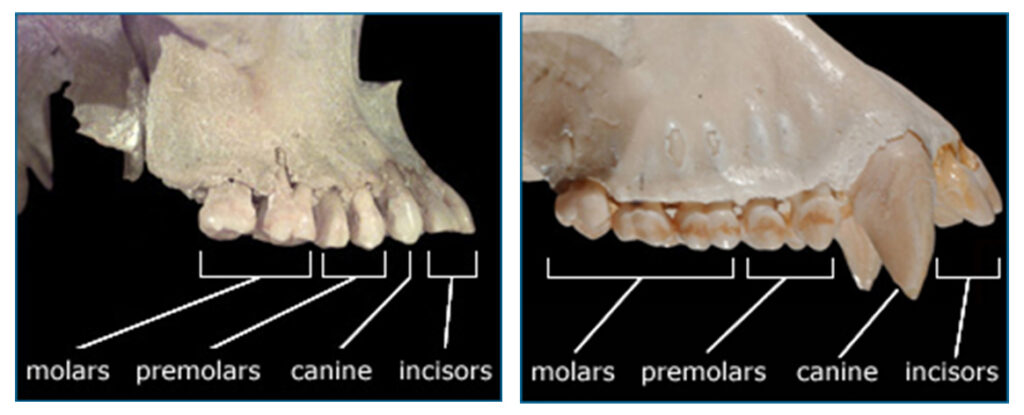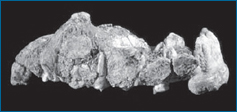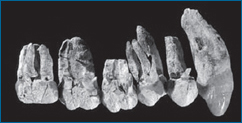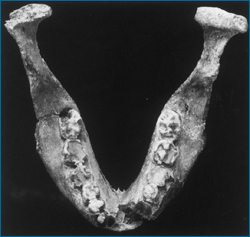Compared to our evolutionary cousins, the chimpanzees, humans have wimpy teeth — our tiny spade-shaped canines, small incisors, and reduced premolars and molars are very different from a chimp’s dentition. But at least we have them beat in the enamel department. Human molars are covered by a thick layer of enamel (much thicker than that of a chimp), which lets us grind up tough foods and protects our teeth from unpleasant (and hard) surprises in our diet — like un-popped popcorn kernels.

But modern humans and chimps are just two surviving branches on what was once a more diverse family tree. How did the teeth of our close relatives measure up? Here’s a rundown of some our relatives with distinct dentitions:
-

Ardipithecus ramidus teeth. Reprinted by permission from Macmillan Publishers Ltd. Ardipithecus ramidus, who walked the Earth 4.5 million years ago, sported relatively small molars (though still bigger than ours), with enamel intermediate in thickness between chimps and later hominids, and large (though not apelike) canines.
-

Australopithecus anamensis teeth. Reprinted by permission from Macmillan Publishers Ltd. Four million year old Australopithecus anamensis had larger, sturdier molars and much thicker enamel than Ard. ramidus. They could have eaten a more varied diet than ramidus. Some Au. anamensis individuals still had large canines.
 Australopithecus boisei, on the other hand, lived 1.7 million years ago and seems to have done something unusual with its teeth. Au. boisei had massive grinding teeth with a thick coating of enamel and diminutive front teeth. Furthermore, its skull was configured to provide attachments for huge chewing muscles. Whatever this species was eating must have been pretty tough!
Australopithecus boisei, on the other hand, lived 1.7 million years ago and seems to have done something unusual with its teeth. Au. boisei had massive grinding teeth with a thick coating of enamel and diminutive front teeth. Furthermore, its skull was configured to provide attachments for huge chewing muscles. Whatever this species was eating must have been pretty tough!
Where do modern humans fit in? Well, we seem to be the geeky cousin in need of braces. Our teeth are dwarfed by those of our close relatives — and though we have thicker enamel than some of our relatives, Au. boisei also outdoes us in that department.
White, T.D., G. WoldeGabriel, B. Asfaw, S. Ambrose, Y. Beyene, R.L. Bernor, J.R. Boisserie, B. Currie, H. Gilbert, Y. Haile-Selassie, W.K. Hart, L.J. Hlusko, F.C. Howell, R.T. Kono, A. Louchart, C.O. Lovejoy, P.R. Renne, H. Saegusa, E. Vrba, H. Wesselman, and G. Suwa. 2006. Asa Issie, Aramis, and the origin of Australopithecus. Nature 440:883-889.
Suwa, G., B. Asfaw, Y. Beyene, T.D. White, S. Katoh, S. Nagaoka, H. Nakaya, K. Uzawa, P. Renne, and G. WoldeGabriel. 1997. The first skull of Australopithecus boisei. Nature 389: 489-492.
